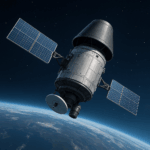
The National Aeronautics and Space Administration (NASA), on Tuesday the 25th of November, 2021 launched a spacecraft with the mission to alter an asteroid path and see the possibility of knocking off a speeding space rock off course if one were to threaten Earth.
The spacecraft known as Double Asteroid Redirection Test (DART) started
off from Vandenberg Space Force Base atop a SpaceX Falcon 9 rocket in a $330 million project with echoes of the Bruce Willis movie “Armageddon.”
The 1,200-pound (540-kilogram) spacecraft is expected to by September 2021 head-on into Dimorphos, an asteroid 525 feet (160 meters) across, at 15,000 mph (24,139 kph) next September.
“This isn’t going to destroy the asteroid. It’s just going to give it a small nudge,” said mission official Nancy Chabot of Johns Hopkins Applied Physics Laboratory, which is managing the project.
A larger asteroid known as Didymos orbits concurrently with Dimorphos with the pair not appearing to the planet Earth, while they allow scientists a better way to measure the effectiveness of a collision than a single asteroid flying through space.
Dimorphos completes one orbit of Didymos every 11 hours, 55 minutes, with the goal of DART is having a crash that slows down Dimorphos, in the process causing it to fall closer toward the bigger asteroid, shaving 10 minutes off its orbit.
The orbital period change which will be measured by Earth telescopes, with 73 seconds the minimum change for the mission to be deemed a success.
The application of the DART technique can be used to alter the course of an asteroid years or decades before it bears down on Earth with the potential for catastrophe.
A small nudge “would add up to a big change in its future position, and then the asteroid and the Earth wouldn’t be on a collision course,” Chabot said.
Scientists will keep searching for asteroids, while plotting their courses to determine if they could hit the planet.
“Although there isn’t a currently known asteroid that’s on an impact course with the Earth, we do know that there is a large population of near-Earth asteroids out there,” said Lindley Johnson, planetary defence officer at NASA. “The key to planetary defence is finding them well before they are an impact threat.”
The Double Asteroid Redirection Test is expected to take 10 months to get to the asteroid pair, with the collision occurring about 6.8 million miles (11 million kilometres) from Earth.
DART will ten days before then release a tiny observation spacecraft supplied by the Italian space agency that will follow it.
DART will stream video until it is destroyed on impact, with the trailing craft making changes on the impact site and the ejected material three minutes later.
Discover more from TechBooky
Subscribe to get the latest posts sent to your email.






